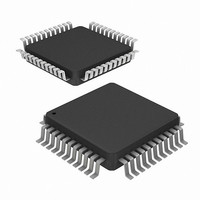HI5762/6IN Intersil, HI5762/6IN Datasheet - Page 14

HI5762/6IN
Manufacturer Part Number
HI5762/6IN
Description
CONV A/DDUAL 10BIT 60MSPS 44MQFP
Manufacturer
Intersil
Datasheet
1.HI57626IN.pdf
(16 pages)
Specifications of HI5762/6IN
Number Of Bits
10
Sampling Rate (per Second)
60M
Data Interface
Parallel
Number Of Converters
8
Power Dissipation (max)
670mW
Voltage Supply Source
Analog and Digital
Operating Temperature
-40°C ~ 85°C
Mounting Type
Surface Mount
Package / Case
44-QFP
Lead Free Status / RoHS Status
Contains lead / RoHS non-compliant
Available stocks
Company
Part Number
Manufacturer
Quantity
Price
Company:
Part Number:
HI5762/6IN
Manufacturer:
HARRIS
Quantity:
120
Static Performance Definitions
Offset Error (V
The midscale code transition should occur at a level
above half-scale. Offset is defined as the deviation of the
actual code transition from this point.
Full-Scale Error (FSE)
The last code transition should occur for an analog input
that is
offset error removed. Full scale error is defined as the
deviation of the actual code transition from this point.
Differential Linearity Error (DNL)
DNL is the worst case deviation of a code width from the
ideal value of 1LSB.
Integral Linearity Error (INL)
INL is the worst case deviation of a code center from a best
fit straight line calculated from the measured data.
Power Supply Sensitivity
Each of the power supplies are moved plus and minus 5%
and the shift in the offset and full scale error (in LSBs) is
noted.
Dynamic Performance Definitions
Fast Fourier Transform (FFT) techniques are used to
evaluate the dynamic performance of the HI5762. A low
distortion sine wave is applied to the input, it is coherently
sampled, and the output is stored in RAM. The data is then
transformed into the frequency domain with an FFT and
analyzed to evaluate the dynamic performance of the A/D.
The sine wave input to the part is typically -0.5dB down
from full scale for all these tests.
SNR and SINAD are quoted in dB. The distortion numbers
are quoted in dBc (decibels with respect to carrier) and DO
NOT include any correction factors for normalizing to full
scale.
The Effective Number of Bits (ENOB) is calculated from the
SINAD data by Equation 1:
where: V
V
amount the analog input signal is backed off from full scale.
ENOB
CORR
3
=
/
adjusts the SINAD, and hence the ENOB, for the
4
(
LSB below Positive Full Scale (+FS) with the
CORR
SINAD 1.76
OS
= 0.5dB (Typ).
–
)
+
V
CORR
14
) 6.02
⁄
1
/
(EQ. 1)
4
LSB
HI5762
Signal To Noise and Distortion Ratio (SINAD)
SINAD is the ratio of the measured RMS signal to RMS
sum of all the other spectral components below the Nyquist
frequency, f
Signal To Noise Ratio (SNR)
SNR is the ratio of the measured RMS signal to RMS noise at
a specified input and sampling frequency. The noise is the
RMS sum of all of the spectral components below f
excluding the fundamental, the first five harmonics and DC.
Total Harmonic Distortion (THD)
THD is the ratio of the RMS sum of the first 5 harmonic
components to the RMS value of the fundamental input
signal.
2nd and 3rd Harmonic Distortion
This is the ratio of the RMS value of the applicable
harmonic component to the RMS value of the fundamental
input signal.
Spurious Free Dynamic Range (SFDR)
SFDR is the ratio of the fundamental RMS amplitude to the
RMS amplitude of the next largest spectral component in the
spectrum below f
Intermodulation Distortion (IMD)
Nonlinearities in the signal path will tend to generate
intermodulation products when two tones, f
present at the inputs. The ratio of the measured signal to the
distortion terms is calculated. The terms included in the
calculation are (f
(f
full scale.
Transient Response
Transient response is measured by providing a full-scale
transition to the analog input of the ADC and measuring the
number of cycles it takes for the output code to settle within
10-bit accuracy.
Over-Voltage Recovery
Over-Voltage Recovery is measured by providing a full-scale
transition to the analog input of the ADC which overdrives
the input by 200mV, and measuring the number of cycles it
takes for the output code to settle within 10-bit accuracy.
Full Power Input Bandwidth (FPBW)
Full power input bandwidth is the analog input frequency at
which the amplitude of the digitally reconstructed output has
decreased 3dB below the amplitude of the input sine wave.
The input sine wave has an amplitude which swings from
-FS to +FS. The bandwidth given is measured at the
specified sampling frequency.
1
+2f
2
), (f
1
-2f
S
/2, excluding DC.
2
). The ADC is tested with each tone 6dB below
1
S
+f
/2.
2
), (f
1
-f
2
), (2f
1
), (2f
2
), (2f
1
1
and f
+f
2
), (2f
January 22, 2010
2
, are
S
1
/2
-f
FN4318.3
2
),









